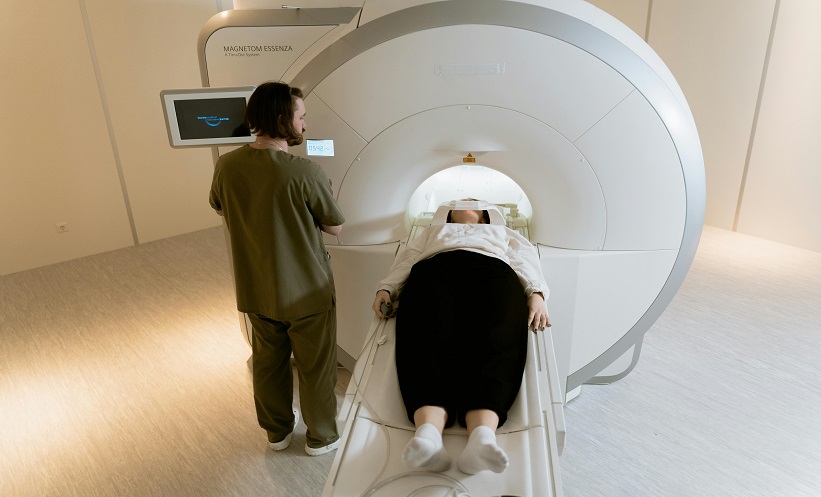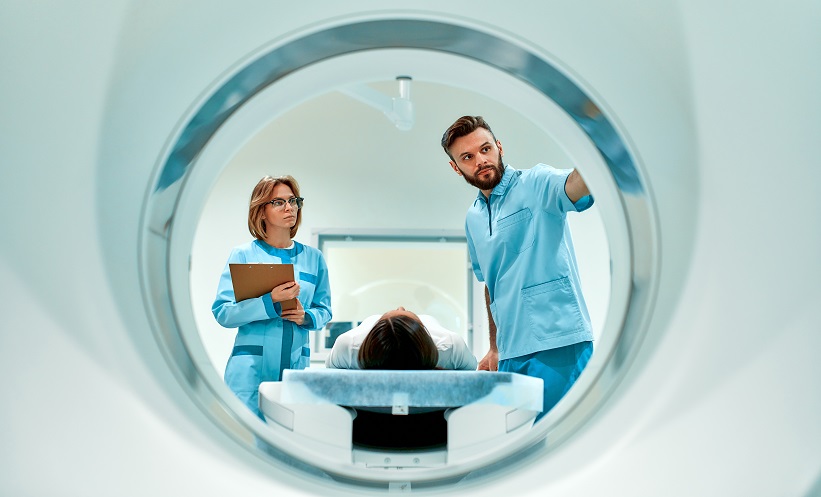VIENNA’S musical culture was a central element throughout the opening ceremony of this year’s European Congress of Radiology (ECR), which opened to the music of Johan Strauss’s ‘Die Fledermaus’, performed by the Philharmonic Five. The musical element continued to manifest itself as the musicians performed classical pieces throughout the ceremony ranging from ‘Giuditta’ to ‘Don Giovanni’. Although the coronavirus disease (COVID-19) pandemic forced yet another congress to switch to a virtual setting, Vienna’s character and style was diffused throughout the congress.
In what now seems to be an ironic twist of fate due to the COVID-19 pandemic, last year the European Society of Radiology (ESR) President Prof Michael Fuchsjäger chose ‘embracing’ as the main theme of this year’s ECR. Underpinning this theme was Gustav Klimt’s painting ‘The Kiss’, which served as the signature image of the congress. As elegantly put by Prof Fuchsjäger, embracing is an all-encompassing word and radiology is the one thing that attendees collectively embraced.
In addressing the audience during the opening ceremony, Prof Fuchsjäger emphasised that “At the outbreak of a global pandemic, the ESR chose to embrace the innovative and wide-reaching opportunities that only learning can provide.”
The ESR online platform offered five parallel streams with a plethora of sessions and themes to choose from, which made navigation an engaging and stimulating experience for attendees. Channel 1 contained live broadcasts from a dedicated studio in Vienna acting as a hub and hosting pop-up events from academic and industry partners in 20 different cities around the world. This channel also broadcast classes of yoga, mindfulness, dance, and Aikido, in line with the special theme of this year’s congress: wellbeing. Prof Fuchsjäger expressed his belief that “if we can remain resilient and focussed in the face of adversity, we can serve our patients even more effectively.”
Ranging from plenary lectures and workshops to new horizons sessions and industry symposia, this congress had something for everyone. With presentations on artificial intelligence, radiomics, thera(g)nostics, and Star Wars-themed image interpretation quizzes, there was a wide range of topics and sessions to choose from. Of course, there was an abundance of sessions on COVID-19, ranging from its radiological manifestations, diagnosis, and the use of artificial intelligence.
This year’s recipients of honorary membership, which is awarded to individuals for their scientific excellence, international reputation, and achievements in national or international radiology, were Prof Sanjiv Sam Gambhir, Stanford, California, USA; Prof James P. Borgstede, Colorado, Denver, USA; and Prof Pek-Lan Khong, Hong Kong, SAR, China. A particularly touching tribute was paid to Prof Gambhir who sadly passed away in July 2020, who Prof Fuchsjäger characterised as “a luminary of exceptional style and wisdom.”
The three recipients for this year’s Gold Medal of the ESR were Prof Fiona Gilbert, Cambridge, UK; Prof Paul M. Parizel, Perth, Australia; and Prof Francesco Sardanelli, Milan, Italy. The award is presented to outstanding scientists who work in radiology or life sciences and have been active in the organisation and establishment of radiology in national or international organisations. Each of the recipients chose a favourite piece of music to be played at the ceremony, which ranged from cool jazz to Tchaikovsky. Combining an element of surprise with a touch of Viennese culture, the opening ceremony closed with Prof Fuchsjäger joining the soprano Valentina Nafornita to sing a duet from ‘Don Giovanni’.
This was a truly memorable congress, hosted on a highly innovative platform paving the way for more virtual events organised by the ESR. In the closing ceremony, Prof Fuchsjäger emphasised that “we adapt, we innovate, and we embrace opportunities, no matter what form our annual meeting might take.”
In this issue of EMJ Radiology our team has covered a selection of the topics from ECR, aiming to impart some of the knowledge shared at the congress.
Cardiovascular Magnetic Resonance in Sudden Cardiac Death
SUDDEN cardiac death is unexpected mortality occurring as a result of cardiac causes and within a short time period. The majority of these events are attributable to ventricular arrhythmias. Underlying structural cardiac abnormalities, including postinfarction scar tissue, are found in most cases of sudden cardiac death. During the ECR 2021 Master Class titled ‘Cardiac Imaging in Arrhythmia And Sudden Cardiac Death’, Dr Hubert Cochet, University of Bordeaux, Bordeaux, France, discussed the role of late gadolinium enhanced (LGE) cardiac magnetic resonance (CMR) in scar characterisation.
The current approach for the primary prevention of sudden death relies on the measurement of left ventricular ejection fraction (LVEF). Dr Cochet noted that this methodology cannot be considered satisfactory because a large proportion of patients dying suddenly remain undetected, with >80% of them having LVEF >35%. To overcome LVEF limitations, analysis of LGE CMR images has been proposed. Dr Cochet highlighted a recent study that monitored approximately 1,000 patients with coronary artery disease over 6 years and found that quantification of grey zone on LGE images accurately identified a group at high risk of future arrhythmia. Dr Cochet emphasised: “This strategy clearly outperformed the one based on LVEF measurements, which was poorly discriminate.”
On the topic of nonischaemic dilated cardiomyopathy, Dr Cochet stated: “As opposed to ischaemic heart disease, in which LGE may recruit additional participants for implantable cardioverter defibrillator implantation, LGE in dilated cardiomyopathy may be more useful to prevent unnecessary implantations in a subset of patients who are currently considered for implantation but whose risk profile is rather low.” A further series of studies have illustrated that LGE qualifications could also be used in hypertrophic cardiomyopathy to improve primary prevention.
Lastly, the importance of CMR in the aetiological diagnosis of patients presenting with ventricular arrhythmia was discussed. Dr Cochet stressed that CMR should be performed even when first-line echocardiography and angiography are negative.
Functional Mri for Assessment of Cervical Cancer
THE USE of functional MRI (fMRI) in the evaluation of cervical cancer is increasing. While standard MRI and conventional imaging techniques, such as ultrasound and CT, are effective at detecting tumours that show anatomical distortional and changes in tissue appearance, they often fail to identify the small-volume active tumours, either when they first present or in early disease relapse; the anatomic and functional imaging ability of fMRI makes this possible. Prof Evis Sala, Honorary Consultant Radiologist, Addenbrooke’s Hospital, Cambridge, UK, spoke in a session series on the topic of fMRI in cervical cancer, with particular emphasis on treatment selection, planning, and monitoring.
In helping delineate small tumours, such as adenocarcinoma of the cervix, dynamic contrast-enhanced (DCE) MRI is favourable, especially in patients eligible for trachelectomy (fertility-sparing procedure), due to its ability to noninvasively characterise tissue vasculature. DCE-MRI is also a useful tool in treatment planning (radiotherapy versus surgery) and in evaluating treatment response more readily than assessing tumour size.
There is a growing interest in the use of diffusion-weighted MRI (DWI) in combination with T2-weighted images to measure early treatment response. This is due to the imaging ability to observe reduced profusion in the tumour and is more effective than pattern-monitoring early response to treatment. Prof Sala advised not to use positron emission tomography at treatment completion (3–6-month window), because inflammation and nonspecific glucose uptake give the possibility of false positives; here both DCE-MRI and DWI are more suited. In terms of detecting tumour recurrence, DWI also proves effective at identifying small, subtle areas of tumour.
Prof Sala also mentioned her team’s success in using a combination of positron emission tomography and fMRI for outcome prediction, with both systems serving as disease-free and overall survival biomarkers.
Gadolinium Deposition: An Update
GADOLINIUM-based contrast agents (GBCA) are diagnostic pharmaceutical compounds containing paramagnetic gadolinium ions that affect the magnetic resonance signal properties of surrounding tissue. GBCA are commonly used in clinical practice because of their fundamental ability to selectively decrease the T1 relaxation time within a lesion rather than in normal tissue.
However, during the ECR 2021 Special Focus Session titled ‘Can We Limit Gadolinium Use in Neuroimaging?’, Prof Dragan Stojanov, Centre for Radiology, Clinical Centre of Niš, Niš, Serbia, pointed to several recent studies that demonstrated gadolinium neurodeposition in patients with normal renal function. Specifically, gadolinium deposition has been recorded in brain structures such as the dentate nucleus and globus pallidus. These findings were confirmed in animal models.
Prof Stojanov explained that GBCA can be divided into two structurally distinct categories: linear (open chain) and macrocyclic chelates. The current prevailing theory is that the degree of deposition depends on the molecular structure of the contrast agent used. In particular, dissociation depends on the kinetic and thermodynamic stability of GBCA. The gadolinium ions of macrocyclic GBCA are caged in the cavity of ligands and this is believed to underlie the heightened stability of macrocyclic chelates relative to linear chelates.
The gradual dissociation of accumulated linear GBCA in the brain allows gadolinium to bind proteins and other macromolecules and this process is ultimately responsible for neurodeposition.
On the basis of these findings, Prof Stojanov revealed that the European Medicines Agency (EMA) recommended the suspension of all commercially available linear GBCA. Consequently, many of the less stable chelates have been removed from routine clinical use in recent years.
Prof Stojanov highlighted that there is currently no clinical evidence of adverse health effects specifically related to gadolinium accumulation in the human brain: “In my opinion, future research is needed to determine the mechanism by which gadolinium deposits within the human tissue and whether this leads to clinically significant sequelae.”
How Can Cone-Beam Ct Change Clinicians’ Practice in Interventional Radiology?
THE MAINSTAY of interventional radiology has been 2D angiography, but this has been thwarted by its low contrast resolution. This poses a challenge for small lesions and vessel visibility, resulting in having to take multiple angiograms, which increases radiation dose. Imaging hybrid systems can bridge the gap and give excellent results, but the costs and workflow implications are considered too great a challenge. Cone-beam CT has been around since the early 1990s and earliest applications were for vascular imaging and angiography. At ECR 2021, Dr Raman Uberoi, University of Oxford, Oxford, UK, delivered a presentation entitled ‘How cone-beam CT can change your practice in interventional radiology’ as part of a Master Class on new diagnostic tools for vascular diseases.
As things have progressed over the last 15–20 years, scan times have reduced and multiphasic acquisitions can be obtained. The result is that cone-beam CT provides 3D volume images with great contrast resolution. With cone-beam CT, images can be combined with angiographic images; the correct software allows for treatment planning, catheter and needle navigation, monitoring of treatment, as well as final results assessment.
Excellent training of the patient and staff is vital to the execution of imagery. Cone-beam CT can show the lesion vascular territory at the time of the procedure and offers multimodality fusion, with therapy planning needed for interarterial or percutaneous ablation techniques. These qualities are incredibly valuable as clinicians can automatically identify vessels to be targeted; these vessels can be extracted and lesions targeted.
While the earliest uses of this 3D imaging were for angiography, it can be extremely useful in identifying and targeting branch vessels as well as problems that might compromise stent graft.
Cone-beam CT is now widely available from many manufacturers and its use can be extended to an increasing range of areas including information retrieval. Innovative equipment and further development of software and hardware for this imaging technique improve speed accuracy and safety procedures, ultimately improving patient outcomes.
Radiographers and Patient-Centred Care
IN THE PAST decade, there has been a paradigm shift in healthcare systems to suggest that patient satisfaction has become an important factor for healthcare professionals to consider. Patient-centred care means the needs of the patient are addressed, their questions are answered effectively, and the overall patient experience is improved. In medical imaging, image quality, radiation dose, and other technical aspects are essential; however, patient centred-care was a key subject addressed at ECR 2021.
A quality improvement methodology research study from Warrington and Halton Hospitals NHS Trust, Warrington, UK, led by radiographers Drs Louise Harding and Paula Evans, titled ‘Always about’, was introduced at this year’s congress. This methodology uses the Plan-Do-Study-Act (PDSA) cycle by encouraging honest and transparent feedback from patients and reviewing this feedback to make the required changes. The aim was to inspire radiographers: to increase patient engagements in their treatment, listen to patients’ needs and concerns, avoid making assumptions, address gaps in the quality care systems, and to improve overall radiographic practice and teamwork.
Dr Andrew England, senior lecturer at Keele University, Keele, UK, outlined the role of the European Federation of Radiography Societies (EFRS) and its initiatives for promoting patient-centred care across Europe. The EFRS is the European voice of radiographers and currently represents over 100,000 radiographers and 8,000 students. It recognises 40 national societies and over 60 radiography educators from Europe and beyond. The core belief of the society is essentially putting patients first by finding ways to enhance quality of care in medical imaging and radiography.
Studies have shown that by bringing the patient to the centre of defining their care needs, the safety and effectiveness of care can improve significantly. Quality improvement methodologies can positively impact patience experience and appreciate how patient-centred care has an impact on radiographic practice.
The Alara Principle: Dose Reduction in Ct and Radiography for Children
SPECIAL training is required when utilising medical radiation in paediatric patients. The ‘ALARA’ principle (which stands for ‘as low as reasonably achievable’) is a safety concept used to protect patients from excessive exposure to ionising radiation. In radiography, certain exposure techniques are required when treating small children thanks to their weight–mass ratio. A session was presented at ECR 2021 by Dr Erich Sorantin, Medical University of Graz, Graz, Austria, and Dr Jeannette Kraft, Leeds Teaching Hospitals NHS Trust, Leeds, UK, on avoiding or reducing ionising radiation in children.
Prof Sorantin started the session by evaluating how to improve the benefit and risk ratio of children in radiography and CT by adapting exposure and dose settings to paediatric needs. Tips were shared on how patient positioning and using the slice thickness approach in radiography is essential in dose reduction. It was suggested that a child with spinal deformity or scoliosis could have an MRI scan first, perhaps followed by a focussed CT scan of any bony fusion anomaly.
CT scans are essential in acute trauma for 3D imaging of deformities and assessment of post-traumatic complications causing plate fusion or bone infection. Dr Kraft, a specialist in musculoskeletal radiology, discussed how medical imaging procedures need to be justified and optimised for radiological protection, especially in children. An example was shared to explain that although CT may be appropriate to assess a triplane fracture of the ankle, it is not needed for all ankle fractures in children.
Ultrasound was suggested as the first-line imaging investigation in “lumps and bumps” and nontraumatic joint pain. Possibilities for low-dose applications in skeletal imaging were presented in this session at ECR 2021. A good example was shown in which a low-dose video graphic system allows for total body imaging in a natural, weight-bearing position, producing viewable 2D images and 3D models. Dr Kraft affirmed its use for imaging of scoliosis or lower limb deformities.
Using Artificial Intelligence to Improve Radiomics in Breast Imaging
RADIOMICS, a relatively new field in radiology, is the method of extracting large numbers of quantitative features from medical images using data characterisation algorithms and was the topic of discussion at an ECR 2021 Master Class. Dr Riste Mann, Radiologist, Radbound University Medical Center, Nijmegen, the Netherlands, took to the screen in the final lecture of the Master Class to discuss the use of artificial intelligence (AI) in improving breast imaging ‘-omics’.
AI can be divided into different subfields depending on the particular goals and tools, such as machine learning and robotics. Deep learning represents a subfield of machine learning that structures algorithms in layers to create a convolutional neural network (CNN); in radiology, a CNN uses image inputs to learn and recognise image features and, as a result, makes intelligent decisions and interprets radiographic images independently. In the case of breast imaging, CNN are en route to classifying breast lesions never seen before by the system, simply by using the information obtained from prior cases. Traditional breast MRI is high-dimensional and multiparametric in nature, making interpretation labour intensive and complex with the potential of interobserver variability. Therefore, Dr Mann, along with a team of researchers, set out to uncover whether automated classification of benign and malignant breast lesions in ultrafast breast MRI using deep learning showed a reduction in the number of false-positive biopsies. The team analysed 576 lesions imaged with MRI and applied deep learning methods. The results reported that 19 fewer false positives were produced with the AI system than the number of biopsied benign lesions in the authors’ database, suggesting that AI-based classifications can help radiologists interpret MRI images to improve specificity.
The potential use of AI to predict response to chemotherapy during treatment was also briefly discussed, however this application is not as near in the future as lesion prediction. One day, AI in breast imaging will have the capability to segment, identify, and classify lesions, predict chemotherapy response, and provide a prognosis, all in the same algorithm. “By that time, our jobs will have changed dramatically,” concluded Mann. “We might have somehow all become oncologists.”
A limitation to CNN is that they require large pools of training images before achieving a clinically useful performance. Future studies should focus on collecting larger datasets to further train AI systems and create deeper CNN structures for improved learning and classification.








